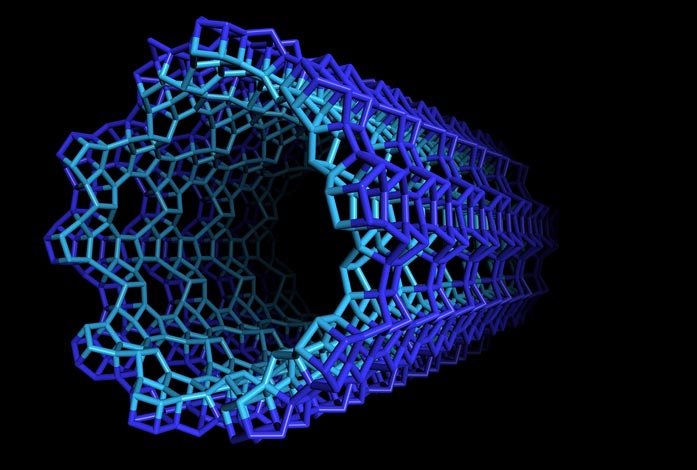Zeolite nanotube discovery made by researchers at Georgia Tech

The single-walled zeolitic nanotube is composed of a microporous aluminosilicate wall encapsulating a hollow mesoporous core.
Credit: Tom Willhammar, Stockholm University
Zeolites, which are crystalline porous materials, are very widely used in the production of chemicals, fuels, materials, and other products. So far, zeolites have been made as 3D or 2D materials. This has changed with the recent discovery of crystalline zeolites in a nanotubular (1D) shape, by researchers at the Georgia Institute of Technology, Stockholm University, and Penn State University. The findings were published in the Jan. 6 issue of Science.
“A discovery like this is one of the most exciting parts of our research,” said Sankar Nair, principal investigator and professor in the School of Chemical & Biomolecular Engineering at Georgia Tech. “We’re increasingly used to doing research that has a pre-determined application at the end of it, so this is a reminder that fundamental discoveries in materials science are also exciting and important.”
Zeolites have pores roughly the size of many types of molecules, and scientists and engineers have used the varied sizes, shapes, and connections of the pores to discriminate between molecules of different sizes, allowing for the production of chemicals suitable for plastic production, or for the separation of undesired molecules from desired ones, as examples.
The team was designing syntheses to assemble 2D zeolite materials. In an unexpected turn of events, some of the results indicated that a new type of assembly process was occurring. Indeed, one such case led to a novel 1D zeolite material that had a tube-like structure with perforated porous walls. This 1D material, termed a zeolitic nanotube, was unlike any zeolite ever synthesized or discovered in nature previously.
“Zeolite nanotubes could be used to make entirely new types of nanoscale components that can control transport of mass or heat or charge, not only down the length of the tube the pipe, but also in and out through the perforated walls,” said Nair.
Resolving the detailed arrangement of the atoms in the zeolite nanotube was a challenging task, for which the Georgia Tech researchers teamed up with zeolite crystallography experts at Stockholm University and Penn State. They found that the nanotube walls had a unique arrangement of atoms that are not known in 3D or 2D zeolites. This same arrangement is also responsible for forcing the zeolite to form as a 1D tube rather than a 2D or 3D material.
“This is the first example of a new class of nanotubes, and its unique and well-defined structure provides exciting ideas and opportunities to design zeolite nanomaterials,” said Tom Willhammar, co-investigator and researcher at Stockholm University. “Through further work, we hope that different zeolitic nanotubes could be obtained with variations in pore size, shape and chemistry.”
Put plainly – a nanometer-scale tube made from a 1D material with regular, perforated holes on the sides is now available for exploration. In addition to this being a fundamental scientific discovery that could change the way we think about designing porous materials, the researchers see potential for many practical applications.
“The unique structural attributes of these materials will allow for an array of potential applications in membrane separations, catalysis, sensing, and in energy devices where mass or energy transport are crucial,” said Christopher W. Jones, co-principal investigator and professor at Georgia Tech. “The materials may have unique mechanical properties, as well, finding applications in composite materials, as carbon nanotubes have done. At this stage, the sky is the limit, and we hope researchers will look for creative ways to deploy these materials for the benefit of humanity.”
CITATION: Akshay Korde, Byunghyun Min, Elina Kapaca2, Omar Knio, Iman Nezam, Ziyuan Wang, Johannes Leisen, Xinyang Yin, Xueyi Zhang, David S. Sholl, Xiaodong Zou, Tom Willhammar, Christopher W. Jones, Sankar Nair. “Single-walled zeolitic nanotubes.” Science. 6 Jan 2022.
FUNDING: National Science Foundation (Grant No. CBET-1534179)
The Georgia Institute of Technology, or Georgia Tech, is a top 10 public research university developing leaders who advance technology and improve the human condition. The Institute offers business, computing, design, engineering, liberal arts, and sciences degrees. Its nearly 44,000 students representing 50 states and 149 countries, study at the main campus in Atlanta, at campuses in France and China, and through distance and online learning. As a leading technological university, Georgia Tech is an engine of economic development for Georgia, the Southeast, and the nation, conducting more than $1 billion in research annually for government, industry, and society.
Contact: Georgia Parmelee | georgia.parmelee@gatech.edu
Journal: Science
DOI: 10.1126/science.abg3793
Method of Research: Observational study
Subject of Research: Not applicable
Article Title: Single-walled zeolitic nanotubes
Media Contact
Georgia Parmelee
Georgia Institute of Technology
georgia.parmelee@gatech.edu
Office: 404-281-7818
Original Source
All latest news from the category: Materials Sciences
Materials management deals with the research, development, manufacturing and processing of raw and industrial materials. Key aspects here are biological and medical issues, which play an increasingly important role in this field.
innovations-report offers in-depth articles related to the development and application of materials and the structure and properties of new materials.
Newest articles

Simplified diagnosis of rare eye diseases
Uveitis experts provide an overview of an underestimated imaging technique. Uveitis is a rare inflammatory eye disease. Posterior and panuveitis in particular are associated with a poor prognosis and a…

Targeted use of enfortumab vedotin for the treatment of advanced urothelial carcinoma
New study identifies NECTIN4 amplification as a promising biomarker – Under the leadership of PD Dr. Niklas Klümper, Assistant Physician at the Department of Urology at the University Hospital Bonn…

A novel universal light-based technique
…to control valley polarization in bulk materials. An international team of researchers reports in Nature a new method that achieves valley polarization in centrosymmetric bulk materials in a non-material-specific way…





















